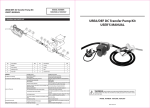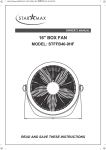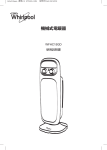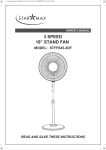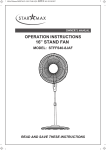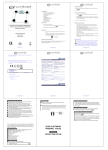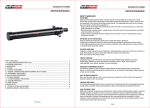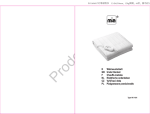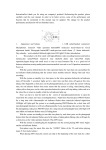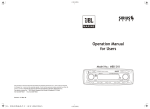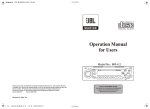Download UREA/DEF AC Transfer Pump Kit USER'S MANUAL
Transcript
UREA/DEF AC Transfer Pump Ki USER’S MANUAL UREA/DEF AC Transfer Pump Kit USER’S MANUAL MODEL NUMBER 10302500 & 10302501 & 10302502 & 10302503 & 10302504 &10302505 A. MACHINE DESCRIPTION PUMP: Self-priming, volumetric, diaphragm pump, equipped with by-pass valve. MOTOR: Asynchronous motor, single-phase, 2 pole, closed type (protection class IP55 in conformance with EN 60034-5-86 regulations) self-ventilated. B. TECHNICAL DATA B1. Configuration Item No. Pump Model Voltage Suction Hose Delivery Hose Nozzle Flow Meter 10302500 17350250 230V 1.5M 6M Manual N/A 10302501 17350251 120V 1.5M 6M Manual N/A 10302502 17350250 230V 1.5M 6M Manual Yes 10302503 17350251 120V 1.5M 6M Manual Yes 10302504 17350250 230V 1.5M 6M Auto Yes 10302505 17350251 120V 1.5M 6M Auto Yes C. OPERATING CONDITIONS C1. ENVIRONMENTAL CONDITIONS TEMPERATURE: Min. -10˚C(14˚F) / Max. +60˚C(140˚F) RELATIVE HUMIDITY: Max. 90% ATTENTION! The temperature limits shown apply to the pump components and must be respected to avoid possible damage or malfunction. C2. ELECTRICAL POWER SUPPLY Depending on the model, the pump must be supplied by a single-phase alternating current line whose nominal values are shown in the table in Paragraph B1 – ELECTRICAL SPECIFICATIONS. The maximum acceptable variations from the electrical parameters are: Voltage: +/-5% of the nominal value Frequency: +/-2% of the nominal value ATTENTION! Power from lines with values outside the indicated limits can damage the electrical components. C3. WORKING CYCLE The pumps are designed for continuous use under maximum back pressure. ATTENTION! Functioning under by-pass conditions is only allowed for brief periods of time (2-3minutes maximum). C4. FLUIDS PERMITTED PERMITTED • Chemical products: Urea, weak acid & weak alkaline fluid etc. • Water D. MOVING AND TRANSPORT Given the limited weight and size of the pumps (see overall dimensions), moving the pumps does not require the use of lifting devices. The pumps were carefully packed before shipment. Check the packing material on delivery and store in the dry place. WARNING: Read carefully and understand all INSTRUCTIONS before operating. Failure to follow the safety rules and other basic safety precautions may result in serious personal injury. MODEL NUMBER: 10302500, 10302501, 10302502, 10302503, 10302504, 10302505 REV 02/27/14 E. INSTALLATION E1. DISPOSING OF THE PACKING MATERIAL The packing material does not require special precautions, not being in any way dangerous or polluting. Refer to local regulations for its disposal. E2. PRELIMINARY INSPECTION • Check that the machine has not suffered any damage during transport or storage. • Clean the inlet and outlet openings, removing any dust or residual packing material. • Make sure that the motor shaft turns freely. • Check that the electrical specifications correspond to those shown on the identification plate. 1 of 4 UREA/DEF AC Transfer Pump Ki USER’S MANUAL MODEL NUMBER 10302500 & 10302501 & 10302502 & 10302503 & 10302504 &10302505 E. INSTALLATION UREA/DEF AC TRANSFER PUMP USER’S MANUAL MODEL NUMBER 10302500 & 10302501 & 10302502 & 10302503 & 10302504 &10302505 J.DIMENSIONAL DATA ATTENTION! 326 205 306 THE MOTORS ARE NOT OF AN ANTI-EXPLOSIVE TYPE. Do not install them where inflammable vapours can be present. E3. CONNECTING • Before connection, make sure that the tubing and the suction tank are free of dirt and thread residue that could damage the pump and its accessories. • Do not use conical threaded joints that could damage the threaded pump openings if excessively tightened. Step 1: SUCTION HOSE: - Connect the 1.5M Suction hose by the Hose tail (#8) and Clamp (#12) to the inlet of the pump. Step 2: DELIVERY HOSE: - Connect the 6M Delivery hose by the Hose tail (#8) and Clamp (#12) to the outlet of the pump or the flow meter. Step 3: FLOW METER (Optional): - Connect the flow meter by the Elbow (#9) to the outlet of the pump. Step 4: NOZZLE - Connect the dispensing nozzle by the Clamp (#12) to the delivery hose. E4. DISPENSING After installation the completed pump system as picture indicated, connect the power supply, start dispensing. ATTENTION! It is the installer’s responsibility to use tubing with adequate characteristics. Loosening of the connections (threaded connections, flanging, gasket seals) can cause serious ecological and safety problem. Check all the connections after the initial installation and on a daily basis after that. Tighten the connections, if necessary. F. DAILY USE a. If using flexible tubing, attach the ends of the tubing to the tanks. In the absence of an appropriate slot, solidly grasp the delivery tube before beginning dispensing. b. Before starting the pump, make sure that the delivery valve is closed (dispensing nozzle or line valve). c. Turn the ON/OFF switch to ON. The by-pass valve allows functioning with the delivery closed only for brief periods. d. Open the delivery valve, solidly grasping the end of the tubing. e. Close the delivery valve to stop dispensing. f. When dispensing is finished, turn off the pump. K. PROBLEMS AND SOLUTIONS PROBLEM POSSIBLE CAUSE CORRECTIVE ACTION The Motor is not turning Lack of electric power Check the electrical connecting The motor turns slowly when starting Motor Problems Contact the Service Department Low voltage in the electric power line Bring the voltage back within the anticipated limits Low level in the suction tank Filter clogged Excessive suction pressure ATTENTION! Function with the delivery closed is only allowed for brief periods (2-3 minutes maximum). After using, make sure the pump is turned off. Lower the pump with respect to the level of the tank or increase the cross-section of the tubing High loss of head in the delivery circuit Use shorter tubing or of greater diameter (working with the by-pass open) By-pass valve blocked G. PROBLEMS AND SOLUTIONS Dismantle the valve, clean and/or replace it. Air entering the pump or the suction tubing Check the seals of the Connections H. MAINTENANCE All models are designed and constructed to require a minimum of maintenance. In any case always bear in mind the following basic recommendations for a good functioning of the pump: - On a weekly basis, check that the tubing joints have not loosened, to avoid any leakage. - On a monthly basis, check the pump body and keep it clean of any impurities. - On a weekly basis, check and keep clean the line suction filter. - On a monthly basis, check that the electric power supply cables are in good condition. Use tubing suitable for working under suction pressure Low rotation speed Check the voltage at the pump. Adjust the voltage and/or use cables of greater crosssection The suction tubing is resting on the bottom Raise the tubing of the tank Increased pump noise I. NOISE LEVEL Under normal working conditions the noise emission from all models does not exceed the valve of 80 db at a distance of 1 meter from the electric pump. A narrowing in the suction tubing Leakage from the pump body Cavitation occurring Reduce suction pressure Irregular functioning of the by-pass Dispense fluid until the air is purged from the by-pass system Diaphragm damaged Check and replace the diaphragm J. DISPOSING OF CONTAMINATED MATERIALS In the event of maintenance or demolition of the machine, do not disperse contaminated parts into theenvironment. Refer to local regulations for their proper disposal. 2 of 4 3 of 4 UREA/DEF AC Transfer Pump Kit USER’S MANUAL MODEL NUMBER 10302500 & 10302501 & 10302502 & 10302503 & 10302504 &10302505 7 14 15 16 4 5 6 7 8 9 3 2 10 1 13 12 11 K. DIAGRAM AND PARTS LIST No. Description Qty No. Description Qty 1 Crash gasket 4 9 Delivery hose 6.5m 2 Bracket 1 10 Nut 2(4) 3 Bolt 4 11 Nut 4 4 Nozzle 1 12 Hose clamp 3 5 Nozzle holder 1 13 Suction hose 1.5m 6 Electric pump 7 O-ring 8 Hose tail 1 14 Elbow 1 2(4) 15 Circlip 2 3 16 Flow meter 1 4 of 4 Size: 145x210mm REV 02/27/14



